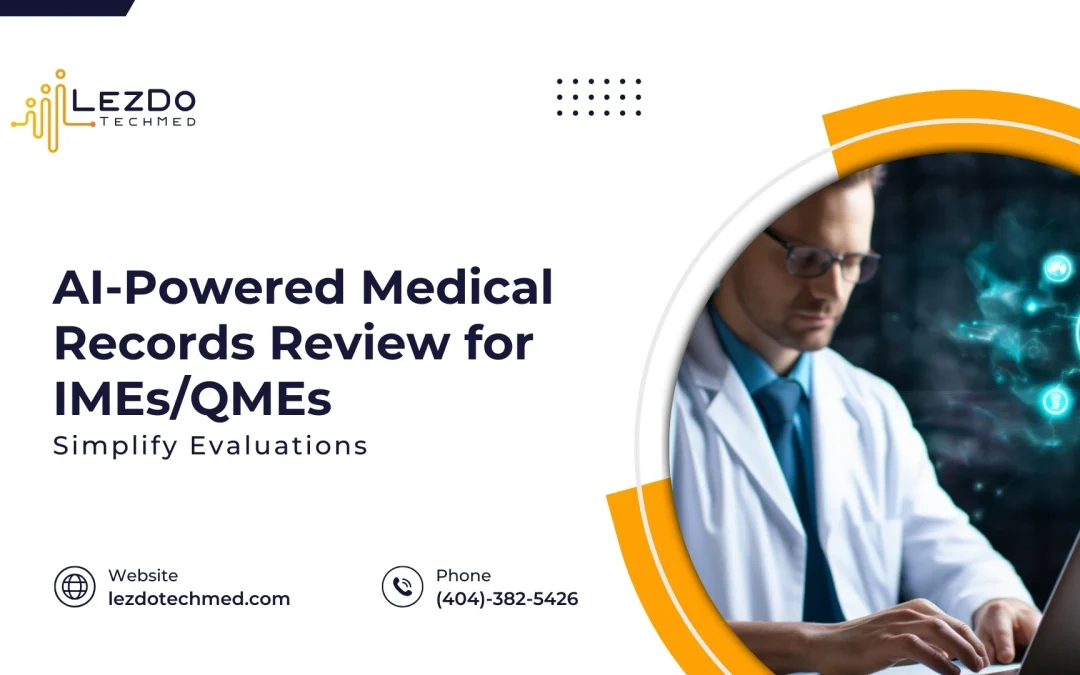Ensuring the confidentiality and security of patient data is crucial in medical and legal claims. Worried about the legal complications of patient data security? By adhering to the stringent guidelines of HIPAA, you can ensure protecting the sensitive patient data, while handling medical charts for legal proceedings.
Before moving into the ways of establishing the privacy of sensitive data using HIPAA, we must know what HIPAA is and the need for HIPAA compliance while patient data handling.
What is HIPAA compliance?
The Health Insurance and Accountability Act (1996), known as HIPAA, issues a list of national regulatory standards to protect individual’s medical records and other personal health information. It covers healthcare providers, health planners, healthcare clearinghouses and the business associates, they deal with. Attorneys need to be HIPAA compliant while handling plaintiff’s medical records to make sure the confidentiality of sensitive personal medical data and to avoid legal repercussions.
The Department of Health and Human Services (HHS) regulates HIPAA compliance and the Office for Civil Rights (OCR) ensures adhering to HIPAA rules.
HIPAA compliance involves safeguarding Protected Health Information (PHI) from unauthorized access and ensuring confidentiality, integrity and availability of even electronic PHI. Electronic PHI (ePHI) is the personal health information that is stored, shared or accessed electronically.
The key provisions of HIPAA standards include:
HIPAA Privacy Rule: Protects the privacy of individually identifiable health information of an individual. It includes the patient’s rightful access to his health information, provider’s rights to deny the PHI access, notices of privacy practices, and the contents of use and disclosure of HIPAA release forms.
HIPAA Security Rule: Sets standards for securing ePHI while maintaining, transferring or handling them. It affirms the staff handling PHI should be trained annually on the policies and regulatory measures of HIPAA.
HIPAA Breach Notification Rule: Requires covered entities to notify affected individuals, the Secretary of Health and Human Services (HHS), and in some cases, the media of a breach of unsecured PHI. All the covered entities and business associates should report the HIPAA breach to the HHS and OCR.
HIPAA Omnibus Rule: Verifies Business Associates to be HIPAA compliant. It also defines the rules for Business Associate Agreements (BAAs). BAA is a type of contract between a covered entity and its business associate prior to sharing any PHI or ePHI.
Strategies for HIPAA Compliance in Chart Reviews

To ensure HIPAA-compliant workflows while handling Electronic Health Records (EHR) and Patient Health Information (PHI), chart review firms should follow certain steps.
- Training and education: Affirm all people involved in chart reviews are through trained on HIPAA regulations. Regular training sessions on updated compliance requirements are essential in maintaining awareness in HIPAA rules.
- Access controls: Implement strict access controls to ascertain that only authorized personnel can access PHI. Use role-based access controls to limit those who need it for their job functions.
- Encrypted data: Encrypt the PHI data while storage as well as data transfer. This asserts that even if the data is accessed by unauthorized individuals, it remains unreadable and secure.
- Secured workplace: Make sure that the workstations used for chart reviews are secure. This includes using strong passwords to workstations and systems, locking screens when not in use, and positioning screens away from public view to prevent unauthorized viewing of PHI.
- Audit trails: Maintain comprehensive audit trails to monitor access to PHI. Regularly review these logs to detect and address any unauthorized access or potential security breaches.
- Data minimization: Limit the amount of PHI accessed and used during chart reviews to the minimum and much needed parts to achieve indented purpose. This reduces the risk of unnecessary exposure of sensitive information.
- Physical security: Confirm the physical locations where chart reviews are conducted are secure. This includes the controlled access to facilities, secured storage for physical records if any, and proper disposal methods for PHI.
- Third-party compliance: If chart reviews are outsourced to third-party vendors, ensure they are HIPAA compliant. This includes conducting due diligence, signing BAA agreements and regularly auditing their HIPAA compliance practices.
- Incident response plan: Develop and implement an incident response plan to address breaches of PHI. This includes procedures for reporting potential PHI breaches, mitigating damage, and notifying the affected parties as required by the HIPAA Breach Notification Rule.
- Regular self-audits and assessments for compliance: Conduct regular audits and risk assessments to identify potential vulnerabilities in your efforts to be HIPAA compliant. Address any issues identified promptly to maintain HIPAA compliance.
Common Challenges in HIPAA Compliant Chart Reviews
Let’s see the factors that can impact the compliance monitoring in chart reviews here.
Frequent HIPAA updates: HIPAA regulations are not static. They keep evolving. Keeping up with the changing HIPAA regulations and training the staff at frequent intervals is a challenging task.
Comprehensive risk assessments: Conducting thorough and regular risk assessments to identify potential data breaches is complex and time-consuming.
Third-party management: Ensuring third-party vendors or business associates comply with HIPAA standards requires ongoing monitoring and due diligence.
Documenting compliance audits: Maintaining detailed documentation of compliance audits is mandatory but burdensome.
Technical security hurdles: Implementing and managing advanced security measures such as encryption and audit controls, can be technologically demanding for smaller firms.
Incident response: Developing and testing strong incident response plans to handle data breaches effectively can be another challenging and time-consuming process.
Frequent employee resignations or replacements: High and frequent staff turnovers or replacements is another challenge. It necessitates continuous training programs and updating knowledge on HIPAA policies to ensure compliance.
By overcoming all these challenges, legal firms can assure HIPAA compliant reviews while handling patient health information.
Best Practices for Chart Reviewers
Double-check permissions: Before accessing any PHI, ensure you have the proper permission and that accessing information is necessary for the task at hand.
Use secure communication channels: When discussing PHI related issues, use secure and encrypted communication channels. Avoid using unsecured emails or communication platforms.
Make the data anonymous, when possible: Whenever and wherever possible, remove or mask the personally identifiable information from the charts being reviewed. This will enhance patient data privacy further.
If attorneys and law firms find HIPAA compliant case review a challenging one, they can outsource it to an experienced chart review company that adheres to HIPAA policies.
Seeking Chart Reviews with High Security?
Does LezDo TechMed comply with HIPAA guidelines? How?
As a recognized medical chart review company, LezDo TechMed adheres to the regulatory standards of HIPAA to ensure security in handling sensitive patient information. We store all the patient information on AWS cloud servers, offering top-tier protection against unauthorized access.
Our communication channels are fortified with SSL encryption and digital signatures, ensuring data integrity and confidentiality during transmission. The robust security measures extend from the moment, an attorney or law firm access our service, throughout their engagement, and beyond, demonstrating our unwavering commitment to data protection.
We use our proprietary web application, CaseDrive, to ensure HIPAA compliance during our chart reviews. Through CaseDrive, we streamline order management, case management, billing and invoice payment, assuring that all the processes are conducted within the framework of HIPAA policies.
We always maintain HIPAA review compliance by offering adequate employee training on secure data handling and stringent access controls. We use strong encryption methods for ePHI, to assure that the patient data is secure both in transit and when stored. Our strict access controls limit information access to authorized personnel only. Our detailed audit trails monitor and log all access to patient records.
We have clear drafting and reviewing policies and procedures for HIPAA compliance while handling, storing and transmitting PHI, and affirm regular internal audits for risk assessments and rectify vulnerabilities. A well-endorsed incident response plan is also in place to manage any potential data breaches swiftly. This enhances compliance with reporting requirements and minimizing impacts.
With our comprehensive approach, combined with certified security protocols, we ascertain that every piece of sensitive information in our HIPAA compliance reviews is handled with utmost care.
Sign up with our CaseDrive to experience our commitment to HIPAA compliance in medical chart reviews.
Ready to get started? Get free trial worth $500. Hurry up!
To wrap up,
HIPAA compliance is a much-needed protocol to affirm protection and security of patient privacy in medical chart reviews. In handling medical-legal claims, attorneys should confirm that the sensitive patient data is secure and out of data breach in every step of chart reviews. Not only attorneys, but also health care facilities should adhere to HIPAA compliance while handling patient data.
By enforcing regular training to the staff on changing HIPAA regulations, data encryption and vigilant auditing, people involved in medical chart reviews can make sure data privacy and integrity. Reach out to LezDo TechMed to get your chart reviews with high security.
Your commitment to patient privacy is our top priority.











